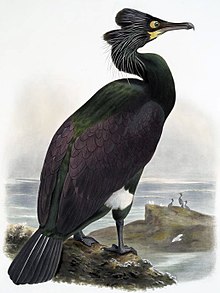| Spectacled cormorant | |
|---|---|

| |
| Illustration by Joseph Wolf | |
| Conservation status | |
 Extinct (c. 1850) (IUCN 3.1) | |
| Scientific classification | |
| Domain: | Eukaryota |
| Kingdom: | Animalia |
| Phylum: | Chordata |
| Class: | Aves |
| Order: | Suliformes |
| Family: | Phalacrocoracidae |
| Genus: | Urile |
| Species: | †U. perspicillatus |
| Binomial name | |
| †Urile perspicillatus (Pallas, 1811) | |
| Synonyms | |
| |
The spectacled cormorant or Pallas's cormorant (Urile perspicillatus) is an extinct marine bird of the cormorant family of seabirds that inhabited Bering Island and possibly other places in the Commander Islands and the nearby coast of Kamchatka in the far northeast of Russia. The modern distribution was shown to be a relict of a wider prehistoric distribution in 2018 when fossils of the species from 120,000 years ago were found in Japan. It is the largest species of cormorant known to have existed.
Taxonomy
It was formerly classified in the genus Phalacrocorax, but in 2021, the IOC reclassified it and several other Pacific cormorant species into the genus Urile, based on a 2014 study that supported reclassifying the Brandt's, red-faced, and pelagic cormorants into that genus. Although the spectacled cormorant was not mentioned in the 2014 study and its current taxonomic position is unresolvable by the current phylogenies, it was also reclassified into Urile based on its perceived relatedness to those species.
Description
The species was first identified by Georg Wilhelm Steller in 1741 on Vitus Bering's disastrous second Kamchatka expedition. He described the bird as large, clumsy and almost flightless – though it was probably reluctant to fly rather than physically unable – and wrote "they weighed 12–14 pounds, so that one single bird was sufficient for three starving men." Though cormorants are normally notoriously bad-tasting, Steller says that this bird tasted delicious, particularly when it was cooked in the way of the native Kamchadals, who encased the whole bird in clay, buried it, and baked it in a heated pit.
With a body mass estimated to be from 3.5 to 6.8 kg (7.7 to 15.0 lb) and a length up to around 100 cm (39 in), the spectacled cormorant was rather larger than all other known cormorants. In a similar fashion to the extant flightless cormorant, which may have rivaled it in length but not weight, the spectacled cormorant is thought to have at least largely lost the power of flight which is borne out by the reduced sternum and wing chord of museum specimens. This species was largely glossy black in color with a reported greenish gloss that may have been fairly vivid in bright light.
A contrasting large white patch could be seen on its lower flanks just above the legs. Like other cormorants, they had small patches of bare skin about the face including a small gular patch and a small amount of bare skin around the eyes; these areas usually appeared to have been dull-yellow or grayish in hue, but during breeding stages, they may have changed to a bright orangey-reddish hue. During breeding stages, they also had a prominent crest on their head. The bare skin around the eyes, as well as the crest, were not present in females.
Extinction
Apart from the fact that it fed on fish, almost nothing else is known about the life history of this bird. The population declined quickly after further visitors to the area started collecting the birds for food and feathers. Their reports of profitable whaling grounds and large populations of Arctic foxes and other animals with valuable pelts led to a massive influx of whalers and fur traders into the region; the last birds were reported to have lived around 1850 on Kamen Ariy (Russian: Камень Арий) islet, off the northwestern tip of Bering Island.
Only seven known specimens are currently preserved in public collections, with all specimens collected and given away by the same individual. None of these specimens are available on public display.
A presumed prehistoric record from Amchitka Island, Alaska, is based on misidentification of double-crested cormorant remains.
See also
References
- ^ BirdLife International (2023). "Urile perspicillatus". IUCN Red List of Threatened Species. 2023: e.T22696750A226827998. doi:10.2305/IUCN.UK.2023-1.RLTS.T22696750A226827998.en.
- Phalacrocorax, Ancient Greek word for cormorants (literally "bald raven"). perspicillatus, Latin for "spectacled", in allusion of the birds' large size.
- Watanabe, Junya; Matsuoka, Hiroshige; Hasegawa, Yoshikazu (October 2018). "Pleistocene fossils from Japan show that the recently extinct Spectacled Cormorant (Phalacrocorax perspicillatus) was a relict". The Auk. 135 (4): 895–907. doi:10.1642/AUK-18-54.1. hdl:2433/233910. S2CID 91465582.
- Kennedy, Martyn; Spencer, Hamish G. (1 October 2014). "Classification of the cormorants of the world". Molecular Phylogenetics and Evolution. 79: 249–257. doi:10.1016/j.ympev.2014.06.020. ISSN 1055-7903. PMID 24994028.
- "Taxonomic Updates – IOC World Bird List". Retrieved 28 July 2021.
- Ellis, Richard (2004). No Turning Back: The Life and Death of Animal Species. New York: Harper Perennial. p. 135. ISBN 0-06-055804-0.
- Hume, J. P., & Walters, M. (2012). Extinct birds (Vol. 217). A&C Black.
- Grzimek, B. (1972). Grzimek's Animal Life Encyclopedia: Birds I-III. Van Nostrand Reinhold Company.
- Roots, C. (2006). Flightless birds. Greenwood Publishing Group.
- ^ King, R. J. (2013). The Devil's Cormorant: a Natural History. University of New Hampshire Press.
- ^ Fuller, Errol (1987). Extinct Birds. Facts on File. pp. 39. ISBN 0816018332.
- Ariy Kamen. Often misspelled "Aji Kamen" or even "Aii Kimur".
- Siegel-Causey, D.; Lefevre, C. & Savinetskii, A. B. (1991). "Historical diversity of cormorants and shags from Amchitka Island, Alaska" (PDF). Condor. 93 (4): 840–852. doi:10.2307/3247718. JSTOR 3247718. S2CID 88017585.
- Olson, Storrs L. (2005). "Correction of erroneous records of cormorants from archeological sites in Alaska". Condor. 107 (4): 930–933. doi:10.1650/7818.1. S2CID 84570578.
| Order: Suliformes (Phalacrocoraciformes) | |||||||||||||||||||||||
|---|---|---|---|---|---|---|---|---|---|---|---|---|---|---|---|---|---|---|---|---|---|---|---|
| |||||||||||||||||||||||
| |||||||||||||||||||||||
| |||||||||||||||||||||||
| |||||||||||||||||||||||
| Taxon identifiers | |
|---|---|
| Phalacrocorax perspicillatus |
|